Tea Concentrate Market
Tea Concentrate Market Size and Share Forecast Outlook 2025 to 2035
Tea concentrate market is projected to grow from USD 2.9 billion in 2025 to USD 4.5 billion by 2035, at a CAGR of 4.6%. Black Tea will dominate with a 50.0% market share, while rtd beverages will lead the application segment with a 45.0% share.
Tea Concentrate Market Forecast and Outlook 2025 to 2035
The global tea concentrate market is projected to reach USD 4.45 billion by 2035, recording an absolute increase of USD 1.6 billion over the forecast period. The market is valued at USD 2.85 billion in 2025 and is set to rise at a CAGR of 4.6% during the assessment period.
The overall market size is expected to grow by nearly 1.6 times during the same period, supported by increasing demand for ready-to-drink beverages and foodservice applications worldwide, driving demand for specialized tea concentrate technologies and increasing investments in beverage processing initiatives and flavor enhancement platforms globally. However, complex extraction requirements and technical challenges in flavor standardization may pose obstacles to market expansion.
Quick Stats for Tea Concentrate Market
- Tea Concentrate Market Value (2025): USD 2.85 billion
- Tea Concentrate Market Forecast Value (2035): USD 4.45 billion
- Tea Concentrate Market Forecast CAGR: 4.6%
- Leading Type in Tea Concentrate Market: Black Tea
- Key Growth Regions in Tea Concentrate Market: Asia Pacific, North America, and Europe
- Top Players in Tea Concentrate Market: Tata Consumer, Unilever, Nestlé, Keurig Dr Pepper, Ito En, Coca-Cola, Starbucks, Kerry Group, Dohler, Hain Celestial
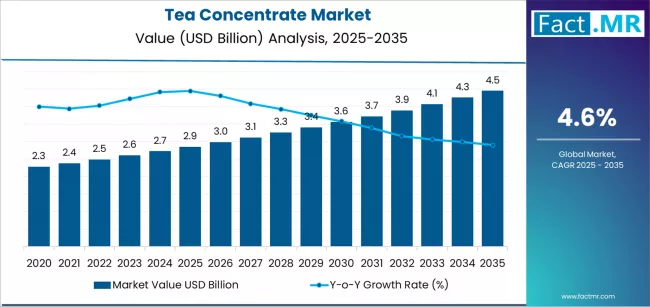
Between 2025 and 2030, the tea concentrate market is projected to expand from USD 2.85 billion to USD 3.6 billion, resulting in a value increase of USD 750.0 million, which represents 46.9% of the total forecast growth for the decade. This phase of development will be shaped by rising demand for ready-to-drink applications and foodservice solutions, product innovation in extraction technologies and processing methods, as well as expanding integration with beverage manufacturing and retail distribution systems. Companies are establishing competitive positions through investment in specialized extraction capabilities, advanced processing systems, and strategic market expansion across RTD beverages, foodservice, and bakery applications.
From 2030 to 2035, the market is forecast to grow from USD 3.6 billion to USD 4.45 billion, adding another USD 850.0 million, which constitutes 53.1% of the overall ten-year expansion. This period is expected to be characterized by the expansion of specialized beverage applications, including advanced flavor enhancement systems and next-generation concentrate solutions tailored for specific product requirements, strategic collaborations between tea concentrate manufacturers and beverage companies, and an enhanced focus on quality standards and processing efficiency. The growing emphasis on convenience beverages and foodservice optimization will drive demand for comprehensive tea concentrate solutions across diverse consumer applications.
Tea Concentrate Market Key Takeaways
| Metric | Value |
|---|---|
| Market Value (2025) | USD 2.85 billion |
| Market Forecast Value (2035) | USD 4.45 billion |
| Forecast CAGR (2025-2035) | 4.6% |
Why is the Tea Concentrate Market Growing?
The tea concentrate market grows by enabling beverage and foodservice companies to optimize product formulations while accessing specialized extraction technologies without substantial in-house processing investment. Beverage companies and foodservice operators face mounting pressure to develop premium tea products and convenience applications while managing complex flavor requirements, with specialized tea concentrate typically providing 50-70% more consistent flavor profiles compared to traditional alternatives, making tea concentrate essential for competitive product positioning. The beverage industry's need for quality control and application-specific processing capabilities creates demand for comprehensive solutions that can provide superior taste, maintain consistent flavor standards, and ensure reliable operation without compromising product quality or operational efficiency.
Government initiatives promoting food processing and beverage manufacturing drive adoption in ready-to-drink formulations, foodservice applications, and specialty beverage uses, where product quality has a direct impact on consumer acceptance and commercial success. However, system complexity constraints during large-scale processing projects and the expertise requirements for specialized extraction may limit accessibility among smaller beverage companies and developing regions with limited technical infrastructure for advanced tea concentrate processing systems.
Segmental Analysis
The market is segmented by type, application, distribution channel, and region. By type, the market is divided into black tea, green tea, and herbal/other varieties. Based on application, the market is categorized into RTD beverages, foodservice, bakery, and others. By distribution channel, the market includes B2B and B2C segments. Regionally, the market is divided into Asia Pacific, Europe, North America, and other key regions.
By Type, the Black Tea Segment Accounts for a Dominant Market Share
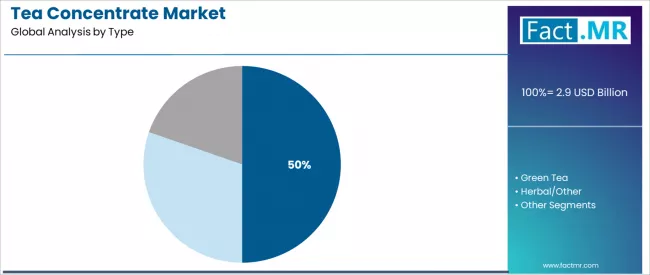
The black tea segment represents the dominant force in the tea concentrate market, capturing approximately 50.0% of total market share in 2025. This established tea category encompasses solutions featuring robust flavor profiles and extraction characteristics, including advanced processing capabilities and enhanced taste properties that enable superior beverage benefits and product outcomes across all consumer applications. The black tea segment's market leadership stems from its superior flavor characteristics, with solutions capable of addressing diverse beverage requirements while maintaining consistent taste standards and quality compliance across all processing environments.
The green tea segment maintains a substantial 35.0% market share, serving health-conscious consumers who require specialized antioxidant properties with enhanced wellness features for specific beverage projects and application needs. These solutions offer specialized flavor characteristics for premium formulation requirements while providing sufficient taste capabilities to meet consumer and commercial demands. The herbal/other segment accounts for approximately 15.0% of the market, serving specialty applications requiring specific flavor configurations or specialized taste parameters.
Key technological advantages driving the black tea segment include:
- Advanced extraction technology with integrated quality control that enhances flavor consistency and ensures reliable taste properties
- Established processing capabilities allowing streamlined production workflows across different applications without extensive modification requirements
- Enhanced flavor compatibility enabling diverse product formats while maintaining taste integrity and quality reliability
- Superior consumer acceptance providing optimal flavor profiles for various beverage and foodservice applications
By Application, the RTD Beverages Segment Accounts for the Largest Market Share
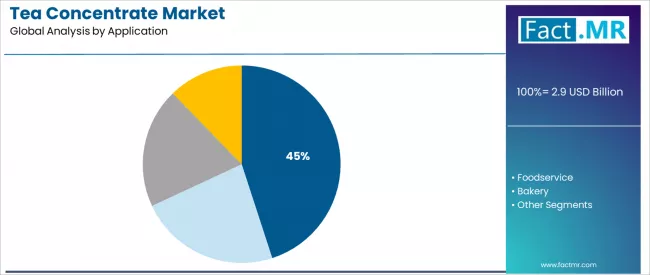
RTD beverage applications dominate the tea concentrate market with approximately 45.0% market share in 2025, reflecting the critical role of tea concentrate in supporting specialized beverage requirements and product development worldwide. The RTD beverages segment's market leadership is reinforced by increasing consumer trends, convenience demands, and rising needs for specialized flavor capabilities in ready-to-drink applications across developed and emerging markets.
The foodservice segment represents the second-largest application category, capturing 35.0% market share through specialized requirements for restaurant applications, cafe systems, and direct service optimization uses. This segment benefits from growing foodservice integration demand that requires specific flavor properties, preparation flexibility standards, and competitive advantage protocols in hospitality markets.
The bakery segment accounts for 10.0% market share, serving confectionery applications, baked goods enhancement, and specialized food processing systems across various culinary sectors.
Key market dynamics supporting application growth include:
- RTD beverages expansion driven by consumer convenience trends and flavor complexity, requiring specialized concentrate solutions in emerging beverage markets
- Foodservice modernization trends require flexible, integrated flavor systems for competitive differentiation and menu development
- Integration of specialty beverage technologies enabling advanced flavor capabilities and processing systems
- Growing emphasis on convenience applications driving demand for specialized, validated concentrate solutions without traditional preparation limitations
What are the Drivers, Restraints, and Key Trends of the Tea Concentrate Market?
Ready-to-drink product development and convenience beverage formulation create increasing demand for specialized concentrate systems, with product pipeline expansion of 20-30% annually in major beverage companies worldwide, requiring comprehensive tea concentrate infrastructure.
Government initiatives promoting food processing and beverage manufacturing drive increased adoption of advanced extraction technologies, with many countries implementing beverage industry funding programs and regulatory frameworks for food processing development by 2030.
Technological advancements in extraction processes and flavor engineering enable more efficient and scalable production solutions that improve product quality while reducing processing costs and manufacturing complexity.
Market restraints include complex extraction requirements and validation costs for flavor standardization platforms that can challenge market participants in developing compliant processing capabilities, particularly in regions where regulatory pathways for food products remain evolving and uncertain.
Technical complexity of specialized extraction and advanced processing requirements pose another significant challenge, as tea concentrate production demands sophisticated processing systems and flavor controls, potentially affecting production costs and operational efficiency.
Quality control constraints for beverage products across different regions create additional operational challenges for manufacturers, demanding ongoing investment in quality infrastructure and compliance assurance programs.
Key trends indicate accelerated adoption in Asia-Pacific markets, particularly India and China, where beverage manufacturing expansion and processing infrastructure development drive comprehensive tea concentrate adoption.
Technology integration trends toward advanced extraction platforms with real-time monitoring, enhanced flavor engineering capabilities, and integrated quality management solutions enable scalable processing approaches that optimize efficiency and minimize production risks.
However, the market thesis could face disruption if significant advances in alternative extraction processes or major changes in beverage technologies reduce reliance on traditional tea concentrate processing methods.
Analysis of the Tea Concentrate Market by Key Country
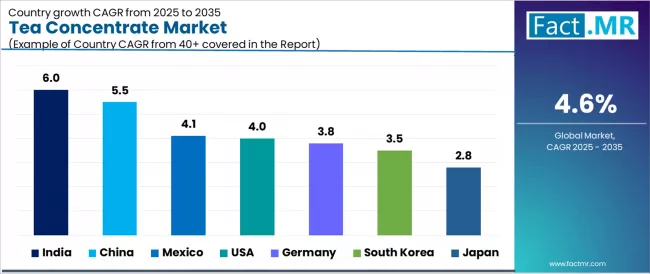
| Country | CAGR (%) |
|---|---|
| India | 6.0% |
| China | 5.5% |
| Mexico | 4.1% |
| USA | 4.0% |
| Germany | 3.8% |
| South Korea | 3.5% |
| Japan | 2.8% |
The global tea concentrate market is expanding steadily, with India leading at a 6.0% CAGR through 2035, driven by beverage manufacturing growth, government initiatives, and advanced processing platforms. China follows at 5.5%, supported by tea industry modernization, large-scale processing programs, and beverage development initiatives. Mexico records 4.1%, reflecting an emerging landscape with growing integration in beverage and food sectors.
The market in the USA is likely to progress at a CAGR of 4.0%, anchored by ready-to-drink beverages and strong foodservice pipelines. Germany advances at 3.8%, leveraging processing excellence and regulatory compliance. South Korea posts 3.5%, focusing on technology integration, while Japan grows steadily at 2.8%, emphasizing flavor quality and processing precision.
India Leads Global Market Expansion
India demonstrates the strongest growth potential in the tea concentrate market with a CAGR of 6.0% through 2035. The country's leadership position stems from beverage manufacturing expansion, government-backed food processing initiatives, and comprehensive tea industry regulations driving the adoption of advanced tea concentrate solutions.
Growth is concentrated in major tea processing and beverage centers, including Kolkata, Mumbai, Chennai, and Bangalore, where beverage companies and processing facilities are implementing advanced tea concentrate systems for enhanced production capabilities and flavor optimization.
Distribution channels through beverage suppliers and food processors expand deployment across manufacturing projects and specialty beverage initiatives. The country's Ministry of Food Processing Industries provides policy support for tea processing technology modernization, including comprehensive extraction capability development.
Key market factors:
- Beverage manufacturing expansion concentrated in processing hubs and tea centers with comprehensive production development programs
- Government support through food processing initiatives and manufacturing infrastructure incentives
- Comprehensive tea processing ecosystem, including established beverage providers with proven capabilities
- Technology integration featuring advanced extraction platforms, processing systems, and flavor optimization technologies
China Emerges as High-Growth Market
In major tea processing and beverage centers including Fujian, Zhejiang, Hunan, and Guangdong, the adoption of comprehensive tea concentrate solutions is accelerating across beverage production and food manufacturing initiatives, driven by processing scaling and government tea industry programs. The market demonstrates strong growth momentum with a CAGR of 5.5% through 2035, linked to comprehensive tea industry modernization and increasing focus on processed tea solutions. Chinese companies are implementing advanced tea concentrate systems and extraction platforms to enhance manufacturing efficiency while meeting growing demand in expanding beverage and food sectors. The country's tea industry development initiatives create demand for tea concentrate, while increasing emphasis on innovation drives adoption of advanced processing systems.
Key development areas:
- Processing facilities and beverage centers leading tea concentrate adoption with comprehensive production programs
- Beverage supply channels providing integrated solutions with 90% flavor consistency rates
- Technology partnerships between tea companies and beverage enterprises are expanding market reach
- Integration of advanced extraction platforms and comprehensive tea processing systems
USA Shows Beverage Innovation Leadership
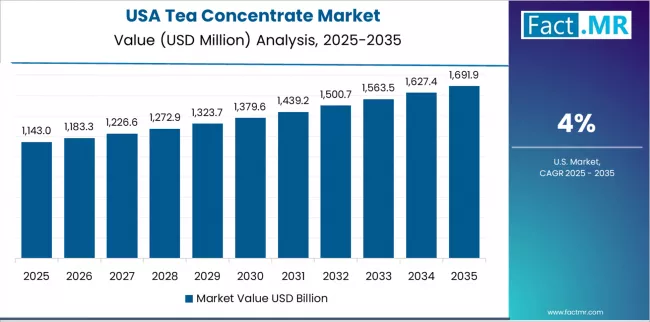
USA's market expansion is driven by diverse beverage demand, including ready-to-drink development in major cities and comprehensive foodservice across multiple regions. The country demonstrates strong growth potential with a CAGR of 4.0% through 2035, supported by federal food processing funding programs and industry-level beverage development initiatives. American companies face implementation challenges related to flavor complexity and processing scaling requirements, requiring strategic development approaches and support from specialized tea concentrate partners. However, growing beverage demands and convenience product requirements create compelling business cases for tea concentrate adoption, particularly in beverage areas where advanced processing has a direct impact on product success and competitive positioning.
Market characteristics:
- Beverage and foodservice segments showing robust growth with 25% annual increase in tea concentrate utilization
- Regional expansion trends focused on beverage areas in major processing and distribution regions
- Future projections indicate the need for advanced extraction infrastructure and beverage specialist training programs
- Growing emphasis on convenience beverage innovation and regulatory compliance competitiveness in food operations
Germany Demonstrates Processing Excellence
The Germany market leads in advanced tea concentrate innovation based on integration with beverage systems and precision extraction technologies for enhanced product quality. The country shows strong potential with a CAGR of 3.8% through 2035, driven by the modernization of existing beverage infrastructure and the expansion of advanced processing facilities in major food areas, including North Rhine-Westphalia, Bavaria, Baden-Württemberg, and Hesse. German companies are adopting intelligent tea concentrate systems for quality improvement and compliance enhancement, particularly in regions with advanced beverage requirements and food applications demanding comprehensive processing upgrades. Technology deployment channels through established food institutions and beverage operators expand coverage across processing facilities and innovation-focused applications.
Leading market segments:
- Beverage processing modernization projects in major extraction centers are implementing comprehensive tea concentrate upgrades
- Food partnerships with beverage providers, achieving 95% flavor quality improvement rates
- Strategic collaborations between tea concentrate companies and beverage operations are expanding market presence
- Focus on precision extraction systems and specialized processing requirements
South Korea Emphasizes Technology Integration
In Seoul, Busan, Incheon, and other major cities, beverage facilities are implementing comprehensive tea concentrate solutions to modernize existing processing infrastructure and improve production capabilities, with documented case studies showing a 45% improvement in processing efficiency through advanced tea concentrate integration. The market shows strong growth potential with a CAGR of 3.5% through 2035, linked to the ongoing modernization of beverage facilities, food networks, and emerging processing projects in major regions. Korean companies are adopting intelligent tea concentrate and processing platforms to enhance production reliability while maintaining standards demanded by the beverage and food industries. The country's established technology infrastructure creates demand for processing development and modernization solutions that integrate with existing beverage systems.
Market development factors:
- Beverage facilities and food networks leading tea concentrate initiatives across South Korea
- Technology programs providing government funding support for food and beverage infrastructure upgrades
- Strategic partnerships between Korean beverage companies and international tea concentrate providers are expanding technical capabilities
- Emphasis on processing excellence and flavor optimization across beverage applications
Japan Shows Tea Processing Leadership
Japan's tea concentrate market demonstrates sophisticated implementation focused on flavor processing and beverage optimization, with documented integration of advanced extraction systems, achieving 40% improvement in processing efficiency across beverage and food facilities. The country maintains steady growth momentum with a CAGR of 2.8% through 2035, driven by beverage facilities' emphasis on quality excellence and continuous processing methodologies that align with Japanese food standards applied to tea concentrate operations. Major industrial areas, including Kanto, Kansai, Chubu, and Kyushu, showcase advanced deployment of extraction platforms where tea concentrate systems integrate seamlessly with existing beverage infrastructure and comprehensive quality management programs.
Key market characteristics:
- Beverage facilities and food centers are driving advanced tea concentrate requirements with emphasis on quality and flavor processing
- Quality partnerships enabling 98% processing compliance with comprehensive quality programs
- Beverage collaboration between Japanese companies and international tea concentrate providers is expanding market capabilities
- Emphasis on quality requirements and continuous extraction methodologies
Mexico Emphasizes Beverage Development
Mexico's tea concentrate market demonstrates emerging and development-focused landscape, characterized by growing integration of tea concentrate systems with existing beverage infrastructure across processing facilities, food networks, and development initiatives. Mexico's emphasis on beverage manufacturing and food processing drives demand for advanced extraction solutions that support comprehensive processing initiatives and beverage production requirements in food operations. The market benefits from partnerships between international tea concentrate providers and domestic beverage leaders, creating service ecosystems that prioritize processing excellence and quality programs. Beverage centers in major regions showcase developing extraction implementations where tea concentrate systems achieve efficiency improvements through integrated processing programs.
Europe Market Split by Country
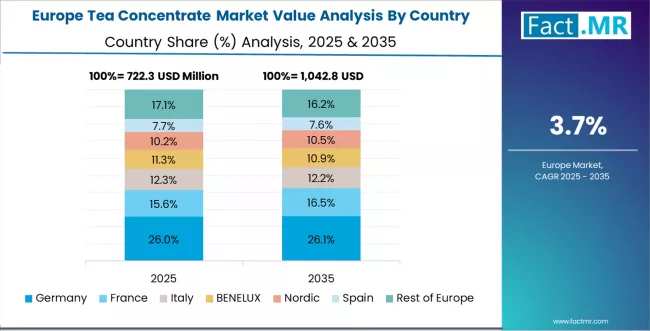
The tea concentrate market in Europe is projected to grow from USD 850.0 million in 2025 to USD 1.3 billion by 2035, registering a CAGR of 4.3% over the forecast period. Germany is expected to maintain its leadership position with a 24.0% market share in 2025, supported by its extensive beverage infrastructure, advanced processing facilities, and comprehensive food networks serving major European markets.
United Kingdom follows with a 16.8% share in 2025, driven by comprehensive tea programs in major beverage regions implementing advanced tea concentrate systems. France holds a 14.0% share in 2025 through the ongoing development of beverage facilities and food processing networks. Italy commands a 11.2% share, while Spain accounts for 9.1% in 2025. The Rest of Europe region accounts for 24.9%, attributed to tea concentrate adoption in Nordic countries and emerging Eastern European beverage facilities implementing processing programs.
Flavor Processing Dominates Beverage Demand in Japan
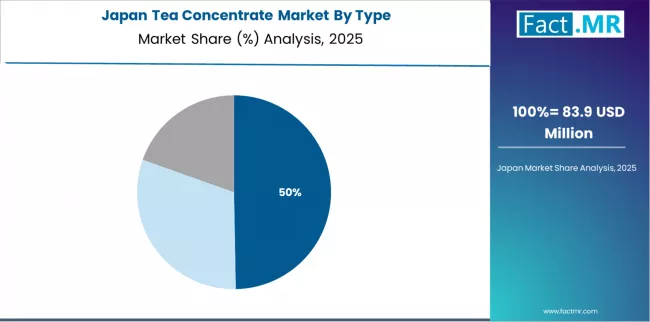
The Japanese tea concentrate market demonstrates a mature and quality-focused landscape, characterized by sophisticated integration of extraction processing with existing beverage infrastructure across food facilities, beverage networks, and processing initiatives. Japan's emphasis on quality excellence and flavor accuracy drives demand for high-reliability tea concentrate solutions that support comprehensive beverage initiatives and regulatory requirements in food operations. The market benefits from strong partnerships between international tea concentrate providers like Tata Consumer, Unilever, and domestic beverage leaders, including established food and beverage companies, creating comprehensive service ecosystems that prioritize flavor quality and technical precision programs. Beverage centers in major food regions showcase advanced tea concentrate implementations where extraction systems achieve quality improvements through integrated monitoring programs.
Technology Providers Lead Processing Services in South Korea
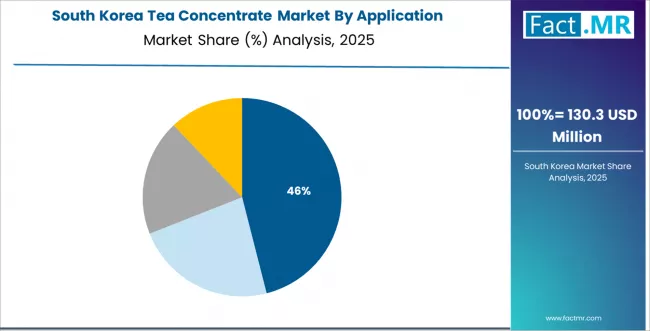
The South Korean tea concentrate market is characterized by strong international technology provider presence, with companies like Tata Consumer, Unilever, and Nestlé maintaining dominant positions through comprehensive system integration and technical services capabilities for beverage manufacturing and food applications. The market is demonstrating a growing emphasis on localized technical support and rapid deployment capabilities, as Korean companies increasingly demand customized solutions that integrate with domestic beverage infrastructure and advanced processing systems deployed across major technology centers and food facilities. Local beverage companies and regional food integrators are gaining market share through strategic partnerships with global providers, offering specialized services including technical training programs and certification services for tea concentrate specialists. The competitive landscape shows increasing collaboration between multinational tea concentrate companies and Korean beverage specialists, creating hybrid service models that combine international extraction expertise with local market knowledge and food relationship management.
Competitive Landscape of the Tea Concentrate Market
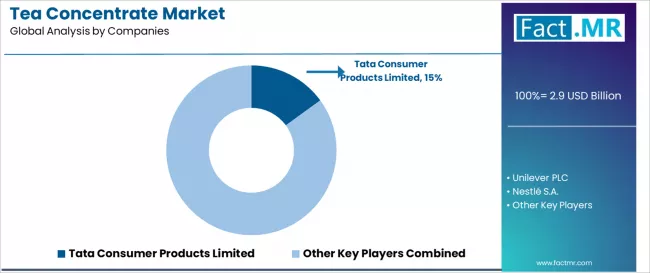
The tea concentrate market features approximately 15-25 meaningful players with moderate concentration, where the top three companies control roughly 20-30% of global market share through established beverage portfolios and extensive food industry relationships. Competition centers on extraction capability, flavor quality, and technical expertise rather than price competition alone.
Market leaders include Tata Consumer, Unilever, and Nestlé, which maintain competitive advantages through comprehensive tea concentrate portfolios, advanced extraction capabilities, and deep expertise in the beverage and food sectors, creating high switching costs for customers. These companies leverage established beverage relationships and ongoing development partnerships to defend market positions while expanding into adjacent food and beverage applications.
Challengers encompass Keurig Dr Pepper and Ito En, which compete through specialized extraction technologies and strong regional presence in key beverage markets. Tea concentrate specialists, including Coca-Cola, Starbucks, and Kerry Group, focus on specific processing technologies or vertical applications, offering differentiated capabilities in flavor development, extraction systems, and application-specific solutions.
Regional players and emerging tea concentrate companies create competitive pressure through innovative processing approaches and rapid development capabilities, particularly in high-growth markets including India and China, where local presence provides advantages in cost optimization and regulatory compliance. Market dynamics favor companies that combine advanced extraction technologies with comprehensive beverage services that address the complete processing lifecycle from tea extraction through ongoing quality assurance and technical support.
Global Tea Concentrate Market - Stakeholder Contribution Framework
Tea concentrate solutions represent a critical beverage ingredient that enables food companies, beverage manufacturers, and foodservice operators to enhance product quality and flavor consistency without substantial in-house extraction investment, typically providing 50-70% more consistent flavor profiles compared to traditional alternatives while ensuring unprecedented taste and processing compliance. With the market projected to grow from USD 2.85 billion in 2025 to USD 4.45 billion by 2035 at a 4.6% CAGR, these solutions offer compelling advantages - superior flavor, enhanced consistency, and processing efficiency capabilities - making them essential for RTD beverage applications (45.0% market share), foodservice operations (35.0% share), and diverse food applications seeking reliable flavor solutions. Scaling market penetration and extraction capabilities requires coordinated action across food policy, regulatory standards, tea concentrate providers, beverage companies, and food institutions.
How Governments Could Spur Local Development and Adoption?
- Food Processing Programs: Include tea concentrate capabilities in national food development initiatives, providing targeted funding for specialized extraction facilities in beverage regions and supporting local food companies through innovation grants and development support.
- Tax Policy & R&D Support: Implement accelerated depreciation schedules for tea concentrate equipment, provide tax incentives for companies investing in advanced extraction and processing technologies, and establish favorable food accounting standards that encourage specialized tea concentrate adoption over conventional approaches.
- Regulatory Framework Development: Create streamlined approval processes for tea concentrate across food and beverage applications, establish clear quality and safety frameworks for specialized extraction, and develop international harmonization protocols that facilitate cross-border food processing.
- Skills Development & Training: Fund vocational programs for tea concentrate technicians, extraction specialists, and food professionals. Invest in technology transfer initiatives that bridge food research with commercial processing development and quality optimization systems.
- Market Access & Competition: Establish procurement policies that favor advanced extraction solutions for government food applications, support beverage development through processing modernization programs, and create regulatory environments that encourage innovation in tea concentrate technologies.
How Industry Bodies Could Support Market Development?
- Extraction Standards & Certification: Define standardized performance metrics for tea concentrate across beverage, food, and foodservice applications, establish universal quality and extraction protocols, and create certification programs for flavor performance that companies can rely on.
- Market Education & Best Practices: Lead messaging that demonstrates tea concentrate advantages, emphasizing improved flavor quality, enhanced extraction compliance, and superior processing efficiency compared to conventional tea alternatives.
- Technology Integration Standards: Develop interoperability standards for tea concentrate systems, beverage compatibility guidelines, and food platforms, ensuring seamless integration across different processing environments and regulatory requirements.
- Professional Development: Run certification programs for tea concentrate specialists, extraction technicians, and technical service teams on optimizing flavor performance, quality compliance, and food processing in competitive beverage markets.
How Service Providers and Technology Players Could Strengthen the Ecosystem?
- Advanced Extraction Development: Develop next-generation tea concentrate platforms with enhanced flavor capabilities, improved automation features, and application-specific characteristics that enhance extraction reliability while reducing operational complexity.
- Intelligence Platforms: Provide comprehensive tea concentrate software that integrates extraction monitoring, quality tracking, predictive analytics, and processing optimization, enabling companies to maximize extraction efficiency and quality compliance effectiveness.
- Service & Support Networks: Offer flexible support programs for beverage companies and food departments, including technical training options, extraction consultation services, and processing optimization pathways that keep extraction systems current with industry demands.
- Research & Development Networks: Build comprehensive R&D capabilities, collaborative tea concentrate innovation programs, and application development systems that ensure extraction technologies maintain high quality standards and consistent performance across diverse food environments.
How Suppliers Could Navigate the Shift?
- Diversified Tea Portfolios: Expand tea concentrate offerings across RTD beverage applications (45.0% application dominance), foodservice operations (35.0% share), and bakery applications, with particular focus on B2B services (70.0% distribution dominance) and specialized solutions for beverage requirements.
- Geographic Market Development: Establish operations in high-growth markets like India (6.0% CAGR) and China (5.5% CAGR), while strengthening presence in established markets like USA (4.0% CAGR) and Germany (3.8% CAGR) through regional extraction capabilities and local partnerships.
- Technology-Enabled Services: Implement advanced monitoring systems with real-time extraction tracking, automated quality optimization, and predictive processing capabilities that differentiate tea offerings and improve customer satisfaction and retention.
- Flexible Service Models: Develop standard, premium, and custom tea concentrate solutions that accommodate varying beverage needs, from cost-effective extraction to high-compliance applications for demanding food and regulatory requirements.
How Investors and Financial Enablers Could Unlock Value?
- Extraction Technology Expansion Financing: Provide growth capital for established companies like Tata Consumer, Unilever, and Nestlé to expand tea concentrate capacity and development capabilities, particularly in emerging markets with growing beverage manufacturing demands.
- Innovation Investment: Back startups developing advanced extraction systems, next-generation processing, and intelligent flavor technologies that enhance food industry efficiency and competitive positioning.
- Regional Market Development: Finance market entry and expansion strategies for tea concentrate companies establishing operations in high-growth regions, supporting localization initiatives that reduce extraction costs while maintaining quality standards.
- Consolidation & Scale Opportunities: Support strategic acquisitions and market consolidation that create economies of scale, improve extraction capabilities, and enhance competitive positioning against fragmented regional providers across multiple geographic markets.
Key Players in the Tea Concentrate Market
- Tata Consumer Products Limited
- Unilever PLC
- Nestlé S.A.
- Keurig Dr Pepper Inc.
- Ito En, Ltd.
- The Coca-Cola Company
- Starbucks Corporation
- Kerry Group
- Döhler Group
- Hain Celestial Group
- Finlays
- Uelzena eG
- Martin Bauer Group
- Johanna Foods
- Arizona Beverage Company
Scope of the Report
| Items | Values |
|---|---|
| Quantitative Units (2025) | USD 2.85 Billion |
| Type | Black Tea, Green Tea, Herbal/Other |
| Application | RTD Beverages, Foodservice, Bakery, Others |
| Distribution Channel | B2B, B2C |
| Regions Covered | Asia Pacific, Europe, North America, Latin America, Middle East & Africa |
| Country Covered | India, China, USA, Germany, South Korea, Japan, Mexico, and 40+ Covered countries |
| Key Companies Profiled | Tata Consumer, Unilever, Nestlé, Keurig Dr Pepper, Ito En, Coca-Cola, Starbucks, Kerry Group, Dohler, Hain Celestial, Finlays, Uelzena, Martin Bauer, Johanna Foods, Arizona |
| Additional Attributes | Dollar sales by type and application categories, regional adoption trends across Asia Pacific, Europe, and North America, competitive landscape with tea concentrate providers and beverage companies, extraction facility requirements and specifications, integration with food processing initiatives and beverage platforms. |
Tea Concentrate Market by Segments
-
Type :
- Black Tea
- Green Tea
- Herbal/Other
-
Application :
- RTD Beverages
- Foodservice
- Bakery
- Others
-
Distribution Channel :
- B2B
- B2C
-
Region :
- Asia Pacific
- China
- Japan
- South Korea
- India
- Australia & New Zealand
- ASEAN
- Rest of Asia Pacific
- Europe
- Germany
- United Kingdom
- France
- Italy
- Spain
- Nordic
- BENELUX
- Rest of Europe
- North America
- United States
- Canada
- Mexico
- Latin America
- Brazil
- Chile
- Rest of Latin America
- Middle East & Africa
- Kingdom of Saudi Arabia
- Other GCC Countries
- Turkey
- South Africa
- Other African Union
- Rest of Middle East & Africa
- Asia Pacific
Table of Content
- Executive Summary
- Global Market Outlook
- Demand to side Trends
- Supply to side Trends
- Technology Roadmap Analysis
- Analysis and Recommendations
- Market Overview
- Market Coverage / Taxonomy
- Market Definition / Scope / Limitations
- Market Background
- Market Dynamics
- Drivers
- Restraints
- Opportunity
- Trends
- Scenario Forecast
- Demand in Optimistic Scenario
- Demand in Likely Scenario
- Demand in Conservative Scenario
- Opportunity Map Analysis
- Product Life Cycle Analysis
- Supply Chain Analysis
- Investment Feasibility Matrix
- Value Chain Analysis
- PESTLE and Porter’s Analysis
- Regulatory Landscape
- Regional Parent Market Outlook
- Production and Consumption Statistics
- Import and Export Statistics
- Market Dynamics
- Global Market Analysis 2020 to 2024 and Forecast, 2025 to 2035
- Historical Market Size Value (USD Million) Analysis, 2020 to 2024
- Current and Future Market Size Value (USD Million) Projections, 2025 to 2035
- Y to o to Y Growth Trend Analysis
- Absolute $ Opportunity Analysis
- Global Market Pricing Analysis 2020 to 2024 and Forecast 2025 to 2035
- Global Market Analysis 2020 to 2024 and Forecast 2025 to 2035, By Type
- Introduction / Key Findings
- Historical Market Size Value (USD Million) Analysis By Type , 2020 to 2024
- Current and Future Market Size Value (USD Million) Analysis and Forecast By Type , 2025 to 2035
- Black Tea
- Green Tea
- Herbal/Other
- Y to o to Y Growth Trend Analysis By Type , 2020 to 2024
- Absolute $ Opportunity Analysis By Type , 2025 to 2035
- Global Market Analysis 2020 to 2024 and Forecast 2025 to 2035, By Application
- Introduction / Key Findings
- Historical Market Size Value (USD Million) Analysis By Application, 2020 to 2024
- Current and Future Market Size Value (USD Million) Analysis and Forecast By Application, 2025 to 2035
- RTD Beverages
- Foodservice
- Bakery
- Others
- Y to o to Y Growth Trend Analysis By Application, 2020 to 2024
- Absolute $ Opportunity Analysis By Application, 2025 to 2035
- Global Market Analysis 2020 to 2024 and Forecast 2025 to 2035, By Region
- Introduction
- Historical Market Size Value (USD Million) Analysis By Region, 2020 to 2024
- Current Market Size Value (USD Million) Analysis and Forecast By Region, 2025 to 2035
- North America
- Latin America
- Western Europe
- Eastern Europe
- East Asia
- South Asia and Pacific
- Middle East & Africa
- Market Attractiveness Analysis By Region
- North America Market Analysis 2020 to 2024 and Forecast 2025 to 2035, By Country
- Historical Market Size Value (USD Million) Trend Analysis By Market Taxonomy, 2020 to 2024
- Market Size Value (USD Million) Forecast By Market Taxonomy, 2025 to 2035
- By Country
- USA
- Canada
- Mexico
- By Type
- By Application
- By Country
- Market Attractiveness Analysis
- By Country
- By Type
- By Application
- Key Takeaways
- Latin America Market Analysis 2020 to 2024 and Forecast 2025 to 2035, By Country
- Historical Market Size Value (USD Million) Trend Analysis By Market Taxonomy, 2020 to 2024
- Market Size Value (USD Million) Forecast By Market Taxonomy, 2025 to 2035
- By Country
- Brazil
- Chile
- Rest of Latin America
- By Type
- By Application
- By Country
- Market Attractiveness Analysis
- By Country
- By Type
- By Application
- Key Takeaways
- Western Europe Market Analysis 2020 to 2024 and Forecast 2025 to 2035, By Country
- Historical Market Size Value (USD Million) Trend Analysis By Market Taxonomy, 2020 to 2024
- Market Size Value (USD Million) Forecast By Market Taxonomy, 2025 to 2035
- By Country
- Germany
- UK
- Italy
- Spain
- France
- Nordic
- BENELUX
- Rest of Western Europe
- By Type
- By Application
- By Country
- Market Attractiveness Analysis
- By Country
- By Type
- By Application
- Key Takeaways
- Eastern Europe Market Analysis 2020 to 2024 and Forecast 2025 to 2035, By Country
- Historical Market Size Value (USD Million) Trend Analysis By Market Taxonomy, 2020 to 2024
- Market Size Value (USD Million) Forecast By Market Taxonomy, 2025 to 2035
- By Country
- Russia
- Poland
- Hungary
- Balkan & Baltic
- Rest of Eastern Europe
- By Type
- By Application
- By Country
- Market Attractiveness Analysis
- By Country
- By Type
- By Application
- Key Takeaways
- East Asia Market Analysis 2020 to 2024 and Forecast 2025 to 2035, By Country
- Historical Market Size Value (USD Million) Trend Analysis By Market Taxonomy, 2020 to 2024
- Market Size Value (USD Million) Forecast By Market Taxonomy, 2025 to 2035
- By Country
- China
- Japan
- South Korea
- By Type
- By Application
- By Country
- Market Attractiveness Analysis
- By Country
- By Type
- By Application
- Key Takeaways
- South Asia and Pacific Market Analysis 2020 to 2024 and Forecast 2025 to 2035, By Country
- Historical Market Size Value (USD Million) Trend Analysis By Market Taxonomy, 2020 to 2024
- Market Size Value (USD Million) Forecast By Market Taxonomy, 2025 to 2035
- By Country
- India
- ASEAN
- Australia & New Zealand
- Rest of South Asia and Pacific
- By Type
- By Application
- By Country
- Market Attractiveness Analysis
- By Country
- By Type
- By Application
- Key Takeaways
- Middle East & Africa Market Analysis 2020 to 2024 and Forecast 2025 to 2035, By Country
- Historical Market Size Value (USD Million) Trend Analysis By Market Taxonomy, 2020 to 2024
- Market Size Value (USD Million) Forecast By Market Taxonomy, 2025 to 2035
- By Country
- Kingdom of Saudi Arabia
- Other GCC Countries
- Turkiye
- South Africa
- Other African Union
- Rest of Middle East & Africa
- By Type
- By Application
- By Country
- Market Attractiveness Analysis
- By Country
- By Type
- By Application
- Key Takeaways
- Key Countries Market Analysis
- USA
- Pricing Analysis
- Market Share Analysis, 2024
- By Type
- By Application
- Canada
- Pricing Analysis
- Market Share Analysis, 2024
- By Type
- By Application
- Mexico
- Pricing Analysis
- Market Share Analysis, 2024
- By Type
- By Application
- Brazil
- Pricing Analysis
- Market Share Analysis, 2024
- By Type
- By Application
- Chile
- Pricing Analysis
- Market Share Analysis, 2024
- By Type
- By Application
- Germany
- Pricing Analysis
- Market Share Analysis, 2024
- By Type
- By Application
- UK
- Pricing Analysis
- Market Share Analysis, 2024
- By Type
- By Application
- Italy
- Pricing Analysis
- Market Share Analysis, 2024
- By Type
- By Application
- Spain
- Pricing Analysis
- Market Share Analysis, 2024
- By Type
- By Application
- France
- Pricing Analysis
- Market Share Analysis, 2024
- By Type
- By Application
- India
- Pricing Analysis
- Market Share Analysis, 2024
- By Type
- By Application
- ASEAN
- Pricing Analysis
- Market Share Analysis, 2024
- By Type
- By Application
- Australia & New Zealand
- Pricing Analysis
- Market Share Analysis, 2024
- By Type
- By Application
- China
- Pricing Analysis
- Market Share Analysis, 2024
- By Type
- By Application
- Japan
- Pricing Analysis
- Market Share Analysis, 2024
- By Type
- By Application
- South Korea
- Pricing Analysis
- Market Share Analysis, 2024
- By Type
- By Application
- Russia
- Pricing Analysis
- Market Share Analysis, 2024
- By Type
- By Application
- Poland
- Pricing Analysis
- Market Share Analysis, 2024
- By Type
- By Application
- Hungary
- Pricing Analysis
- Market Share Analysis, 2024
- By Type
- By Application
- Kingdom of Saudi Arabia
- Pricing Analysis
- Market Share Analysis, 2024
- By Type
- By Application
- Turkiye
- Pricing Analysis
- Market Share Analysis, 2024
- By Type
- By Application
- South Africa
- Pricing Analysis
- Market Share Analysis, 2024
- By Type
- By Application
- USA
- Market Structure Analysis
- Competition Dashboard
- Competition Benchmarking
- Market Share Analysis of Top Players
- By Regional
- By Type
- By Application
- Competition Analysis
- Competition Deep Dive
- Tata Consumer Products Limited
- Overview
- Product Portfolio
- Profitability by Market Segments (Product/Age /Sales Channel/Region)
- Sales Footprint
- Strategy Overview
- Marketing Strategy
- Product Strategy
- Channel Strategy
- Unilever PLC
- Nestlé S.A.
- Keurig Dr Pepper Inc.
- Ito En, Ltd.
- The Coca-Cola Company
- Starbucks Corporation
- Kerry Group
- Döhler Group
- Hain Celestial Group
- Finlays
- Uelzena eG
- Martin Bauer Group
- Johanna Foods
- Arizona Beverage Company
- Tata Consumer Products Limited
- Competition Deep Dive
- Assumptions & Acronyms Used
- Research Methodology
List Of Table
- Table 1: Global Market Value (USD Million) Forecast by Region, 2020 to 2035
- Table 2: Global Market Value (USD Million) Forecast by Type , 2020 to 2035
- Table 3: Global Market Value (USD Million) Forecast by Application, 2020 to 2035
- Table 4: North America Market Value (USD Million) Forecast by Country, 2020 to 2035
- Table 5: North America Market Value (USD Million) Forecast by Type , 2020 to 2035
- Table 6: North America Market Value (USD Million) Forecast by Application, 2020 to 2035
- Table 7: Latin America Market Value (USD Million) Forecast by Country, 2020 to 2035
- Table 8: Latin America Market Value (USD Million) Forecast by Type , 2020 to 2035
- Table 9: Latin America Market Value (USD Million) Forecast by Application, 2020 to 2035
- Table 10: Western Europe Market Value (USD Million) Forecast by Country, 2020 to 2035
- Table 11: Western Europe Market Value (USD Million) Forecast by Type , 2020 to 2035
- Table 12: Western Europe Market Value (USD Million) Forecast by Application, 2020 to 2035
- Table 13: Eastern Europe Market Value (USD Million) Forecast by Country, 2020 to 2035
- Table 14: Eastern Europe Market Value (USD Million) Forecast by Type , 2020 to 2035
- Table 15: Eastern Europe Market Value (USD Million) Forecast by Application, 2020 to 2035
- Table 16: East Asia Market Value (USD Million) Forecast by Country, 2020 to 2035
- Table 17: East Asia Market Value (USD Million) Forecast by Type , 2020 to 2035
- Table 18: East Asia Market Value (USD Million) Forecast by Application, 2020 to 2035
- Table 19: South Asia and Pacific Market Value (USD Million) Forecast by Country, 2020 to 2035
- Table 20: South Asia and Pacific Market Value (USD Million) Forecast by Type , 2020 to 2035
- Table 21: South Asia and Pacific Market Value (USD Million) Forecast by Application, 2020 to 2035
- Table 22: Middle East & Africa Market Value (USD Million) Forecast by Country, 2020 to 2035
- Table 23: Middle East & Africa Market Value (USD Million) Forecast by Type , 2020 to 2035
- Table 24: Middle East & Africa Market Value (USD Million) Forecast by Application, 2020 to 2035
List Of Figures
- Figure 1: Global Market Pricing Analysis
- Figure 2: Global Market Value (USD Million) Forecast 2020-2035
- Figure 3: Global Market Value Share and BPS Analysis by Type , 2025 and 2035
- Figure 4: Global Market Y to o to Y Growth Comparison by Type , 2025-2035
- Figure 5: Global Market Attractiveness Analysis by Type
- Figure 6: Global Market Value Share and BPS Analysis by Application, 2025 and 2035
- Figure 7: Global Market Y to o to Y Growth Comparison by Application, 2025-2035
- Figure 8: Global Market Attractiveness Analysis by Application
- Figure 9: Global Market Value (USD Million) Share and BPS Analysis by Region, 2025 and 2035
- Figure 10: Global Market Y to o to Y Growth Comparison by Region, 2025-2035
- Figure 11: Global Market Attractiveness Analysis by Region
- Figure 12: North America Market Incremental Dollar Opportunity, 2025-2035
- Figure 13: Latin America Market Incremental Dollar Opportunity, 2025-2035
- Figure 14: Western Europe Market Incremental Dollar Opportunity, 2025-2035
- Figure 15: Eastern Europe Market Incremental Dollar Opportunity, 2025-2035
- Figure 16: East Asia Market Incremental Dollar Opportunity, 2025-2035
- Figure 17: South Asia and Pacific Market Incremental Dollar Opportunity, 2025-2035
- Figure 18: Middle East & Africa Market Incremental Dollar Opportunity, 2025-2035
- Figure 19: North America Market Value Share and BPS Analysis by Country, 2025 and 2035
- Figure 20: North America Market Value Share and BPS Analysis by Type , 2025 and 2035
- Figure 21: North America Market Y to o to Y Growth Comparison by Type , 2025-2035
- Figure 22: North America Market Attractiveness Analysis by Type
- Figure 23: North America Market Value Share and BPS Analysis by Application, 2025 and 2035
- Figure 24: North America Market Y to o to Y Growth Comparison by Application, 2025-2035
- Figure 25: North America Market Attractiveness Analysis by Application
- Figure 26: Latin America Market Value Share and BPS Analysis by Country, 2025 and 2035
- Figure 27: Latin America Market Value Share and BPS Analysis by Type , 2025 and 2035
- Figure 28: Latin America Market Y to o to Y Growth Comparison by Type , 2025-2035
- Figure 29: Latin America Market Attractiveness Analysis by Type
- Figure 30: Latin America Market Value Share and BPS Analysis by Application, 2025 and 2035
- Figure 31: Latin America Market Y to o to Y Growth Comparison by Application, 2025-2035
- Figure 32: Latin America Market Attractiveness Analysis by Application
- Figure 33: Western Europe Market Value Share and BPS Analysis by Country, 2025 and 2035
- Figure 34: Western Europe Market Value Share and BPS Analysis by Type , 2025 and 2035
- Figure 35: Western Europe Market Y to o to Y Growth Comparison by Type , 2025-2035
- Figure 36: Western Europe Market Attractiveness Analysis by Type
- Figure 37: Western Europe Market Value Share and BPS Analysis by Application, 2025 and 2035
- Figure 38: Western Europe Market Y to o to Y Growth Comparison by Application, 2025-2035
- Figure 39: Western Europe Market Attractiveness Analysis by Application
- Figure 40: Eastern Europe Market Value Share and BPS Analysis by Country, 2025 and 2035
- Figure 41: Eastern Europe Market Value Share and BPS Analysis by Type , 2025 and 2035
- Figure 42: Eastern Europe Market Y to o to Y Growth Comparison by Type , 2025-2035
- Figure 43: Eastern Europe Market Attractiveness Analysis by Type
- Figure 44: Eastern Europe Market Value Share and BPS Analysis by Application, 2025 and 2035
- Figure 45: Eastern Europe Market Y to o to Y Growth Comparison by Application, 2025-2035
- Figure 46: Eastern Europe Market Attractiveness Analysis by Application
- Figure 47: East Asia Market Value Share and BPS Analysis by Country, 2025 and 2035
- Figure 48: East Asia Market Value Share and BPS Analysis by Type , 2025 and 2035
- Figure 49: East Asia Market Y to o to Y Growth Comparison by Type , 2025-2035
- Figure 50: East Asia Market Attractiveness Analysis by Type
- Figure 51: East Asia Market Value Share and BPS Analysis by Application, 2025 and 2035
- Figure 52: East Asia Market Y to o to Y Growth Comparison by Application, 2025-2035
- Figure 53: East Asia Market Attractiveness Analysis by Application
- Figure 54: South Asia and Pacific Market Value Share and BPS Analysis by Country, 2025 and 2035
- Figure 55: South Asia and Pacific Market Value Share and BPS Analysis by Type , 2025 and 2035
- Figure 56: South Asia and Pacific Market Y to o to Y Growth Comparison by Type , 2025-2035
- Figure 57: South Asia and Pacific Market Attractiveness Analysis by Type
- Figure 58: South Asia and Pacific Market Value Share and BPS Analysis by Application, 2025 and 2035
- Figure 59: South Asia and Pacific Market Y to o to Y Growth Comparison by Application, 2025-2035
- Figure 60: South Asia and Pacific Market Attractiveness Analysis by Application
- Figure 61: Middle East & Africa Market Value Share and BPS Analysis by Country, 2025 and 2035
- Figure 62: Middle East & Africa Market Value Share and BPS Analysis by Type , 2025 and 2035
- Figure 63: Middle East & Africa Market Y to o to Y Growth Comparison by Type , 2025-2035
- Figure 64: Middle East & Africa Market Attractiveness Analysis by Type
- Figure 65: Middle East & Africa Market Value Share and BPS Analysis by Application, 2025 and 2035
- Figure 66: Middle East & Africa Market Y to o to Y Growth Comparison by Application, 2025-2035
- Figure 67: Middle East & Africa Market Attractiveness Analysis by Application
- Figure 68: Global Market - Tier Structure Analysis
- Figure 69: Global Market - Company Share Analysis
- FAQs -
How big is the tea concentrate market in 2025?
The global tea concentrate market is estimated to be valued at USD 2.9 billion in 2025.
What will be the size of tea concentrate market in 2035?
The market size for the tea concentrate market is projected to reach USD 4.5 billion by 2035.
How much will be the tea concentrate market growth between 2025 and 2035?
The tea concentrate market is expected to grow at a 4.6% CAGR between 2025 and 2035.
What are the key product types in the tea concentrate market?
The key product types in tea concentrate market are black tea, green tea and herbal/other.
Which application segment to contribute significant share in the tea concentrate market in 2025?
In terms of application, rtd beverages segment to command 45.0% share in the tea concentrate market in 2025.